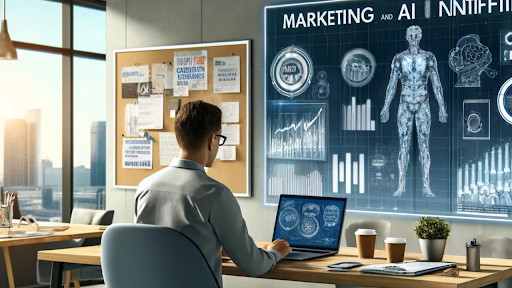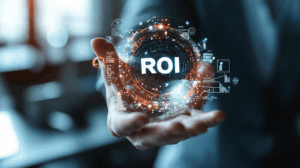
In the fast-evolving marketing world, businesses no longer rely solely on intuition or historical patterns to measure success. Instead, they are turning to Artificial Intelligence (AI) and Machine Learning (ML) to optimize strategies, predict outcomes, and significantly boost Return on Investment (ROI).
This detailed guide will explore how AI and machine learning impact marketing ROI, the tools and techniques marketers should use, real-world examples, and actionable insights for leveraging AI to measure and amplify marketing success.
Understanding the Basics: What Is ROI in Marketing?
Return on Investment (ROI) in marketing measures the profitability of marketing campaigns. It answers the question: “Are we earning more from our marketing investments than we are spending?”
The formula is simple:
Marketing ROI = (Revenue from Marketing – Marketing Costs) / Marketing Costs × 100
While the formula is straightforward, gathering accurate data to plug into this equation is increasingly complex. That’s where AI and machine learning enter the picture—they transform fragmented marketing data into actionable, predictive insights.
The Rise of AI and Machine Learning in Marketing
AI and machine learning have been transformative forces across industries, but their impact on marketing is especially profound:
- Predictive analytics forecasts customer behavior.
- Personalization engines tailor content and offers to individuals.
- Chatbots and virtual assistants automate customer service and lead generation.
- Content generation tools create optimized blogs, ads, and social posts.
- Sentiment analysis gauges brand perception across platforms.
Marketers can now track, predict, and influence every customer touchpoint, creating a full-funnel measurement of marketing success.
Machine Learning (ML) specifically identifies patterns in large datasets, learning and improving without being explicitly programmed, meaning your marketing insights become sharper over time.
How AI Improves Marketing ROI Measurement
Let’s dive into specific ways AI enhances ROI measurement:
1. Advanced Attribution Modeling
One of the biggest challenges marketers face is accurately attributing revenue to the right channel or campaign.
- Traditional models like “last-click” attribution are outdated.
- AI-based models use multi-touch attribution and algorithmic attribution to understand how every interaction (email click, ad view, blog read) contributed to a sale.
This helps marketers allocate budgets more effectively, focusing on what truly drives conversions. In particular, AI-powered Paid Search Intelligence provides deeper visibility into which keywords, ad groups, and campaigns generate the strongest ROI. By analyzing search intent, bid strategies, and competitor activity in real time, it enables marketers to refine paid campaigns with precision and minimize wasted ad spend.
2. Real-Time Performance Tracking
Instead of waiting weeks for marketing reports:
- AI dashboards offer real-time ROI data.
- Marketers can adjust campaigns instantly based on performance.
- Early warning signals help prevent budget waste.
Tools like Google Analytics 4 (GA4), enhanced with machine learning, are already doing this by predicting churn, conversions, and lifetime value.
3. Predictive ROI Analytics
AI models can predict future ROI based on current campaign performance:
- Forecast the success of upcoming promotions.
- Adjust ad spend dynamically across channels.
- Identify underperforming segments before they hurt results.
In 2025, predictive capabilities are not a luxury; they are a competitive necessity.
4. Enhanced Audience Targeting
Machine learning algorithms analyze vast data points:
- Behavioral patterns
- Purchase history
- Social media activity
- Web browsing data
With this, brands can create hyper-targeted audiences who are more likely to convert, ensuring higher ROI from ad spend.
Real-World Case Studies: AI Driving ROI Success
Let’s look at how leading brands use AI to improve their marketing ROI:
Case Study 1: Netflix
- Challenge: Increase subscriber engagement and reduce churn.
- Solution: AI-driven recommendation algorithms.
- Results: Personalized content recommendations lead to 75% of viewer activity, significantly improving customer retention and maximizing lifetime value (LTV).
Case Study 2: Starbucks
- Challenge: Drive customer loyalty and sales.
- Solution: AI-powered app that offers personalized drink suggestions and promotions.
- Results: Increased app engagement and sales per customer by several percentage points, providing a measurable boost in ROI.
Case Study 3: Sephora
- Challenge: Deliver a seamless omnichannel experience.
- Solution: AI chatbots for personalized skincare recommendations.
- Results: Higher online conversion rates and improved in-store sales, directly linked to AI-enhanced customer journeys.
To support similar innovations, many brands turn to MVP development services for startups. These services help quickly prototype and launch AI solutions, ensuring that businesses can adapt and thrive in an ever-evolving market.
Key Metrics to Track AI-Enhanced Marketing ROI
When integrating AI into your marketing efforts, pay close attention to these ROI-related KPIs and growth metrics:
- Customer Acquisition Cost (CAC)
- Customer Lifetime Value (CLV)
- Conversion Rates
- Engagement Metrics (CTR, Open Rates)
- Sales Growth from Campaigns
- Retention Rates
- Churn Rates
- Lead Quality Score
Machine learning models can automate the tracking and analyze the trends behind these numbers, giving you deep insights that manual reporting could never offer.
Tools and Platforms to Leverage in 2025
With Google’s focus shifting toward AI-first indexing and helpful content systems, marketers must embrace modern platforms. One powerful approach includes integrating retrieval-augmented generation (RAG) into content workflows, combining dynamic data fetching with generative AI models for highly relevant outputs. Learning it can help you apply it to your own content marketing or automation stack.
- Google Analytics 4 (GA4): Predictive audiences, automated insights
- HubSpot CRM: AI-driven customer insights and reporting
- Salesforce Einstein: Predictive sales and marketing intelligence
- Adobe Sensei: AI-powered creative and marketing analytics
- ChatGPT and Bard AI: Content creation and customer service automation
- Hootsuite Insights: AI-driven social listening and sentiment analysis
Choosing the right stack ensures you stay ahead of competitors and maximize marketing ROI intelligently. Working with an experienced AI marketing agency can further help align tools, data, and strategy into a unified approach that drives measurable ROI.
Challenges and Limitations to Keep in Mind
AI is not a magic wand. Successful integration into ROI measurement comes with challenges:
- Data Quality Issues: Poor data leads to poor AI outcomes.
- Integration Complexities: AI must integrate across marketing, sales, and service platforms.
- Privacy and Compliance: With GDPR, CCPA, and newer regulations, data use must be transparent and ethical.
- Algorithm Bias: AI models can inherit bias from training data, skewing ROI predictions.
Hence, human oversight, ethical AI practices, and clear governance are critical for sustainable success.
Best Practices for Measuring ROI with AI in 2025
Here’s how to successfully align AI with your marketing ROI goals:
1. Prioritize First-Party Data
With cookie deprecation in full effect, prioritize first-party customer data (your website, app, and CRM data) for machine learning models.
2. Implement Closed-Loop Reporting
Connect marketing data with sales outcomes. AI thrives when it can see the full customer journey.
3. Focus on Customer Lifetime Value (CLV)
Short-term ROI from a single campaign is less important than long-term profitability. Train AI models to optimize for lifetime value, not just clicks or short-term sales.
4. Embrace Agile Marketing
Run experiments, test hypotheses, and iterate rapidly. AI tools love fresh data, and your ROI will grow when you adapt fast.
5. Build Cross-Functional AI Teams
Include marketers, data scientists, technologists, and compliance officers. A diverse team ensures holistic AI marketing success.
Future Outlook: What’s Next for AI and Marketing ROI?
Looking ahead to the next few years:
- Generative AI will autonomously create, test, and optimize marketing campaigns.
- Predictive commerce will customize online stores for every individual user in real-time.
- AI agents will negotiate ad placements and budgets without human intervention.
- Real-time voice analytics will measure customer sentiment during sales calls.
- Blockchain-based AI will improve trust and transparency in marketing data.
Marketers who invest in AI infrastructure, ethical AI practices, and continuous learning will lead the new era of intelligent ROI maximization.
Conclusion
AI and machine learning are no longer futuristic buzzwords; they are the foundation of successful marketing in 2025. By embracing AI-driven measurement tools, adopting predictive analytics, and prioritizing data ethics, businesses can track, predict, and amplify marketing ROI with unprecedented precision.
Success lies in a blend of technology and human intelligence—ensuring AI works for you, not instead of you.
If you want to not only survive but thrive in the marketing world of 2025, it’s time to integrate AI into every aspect of your ROI strategy.



